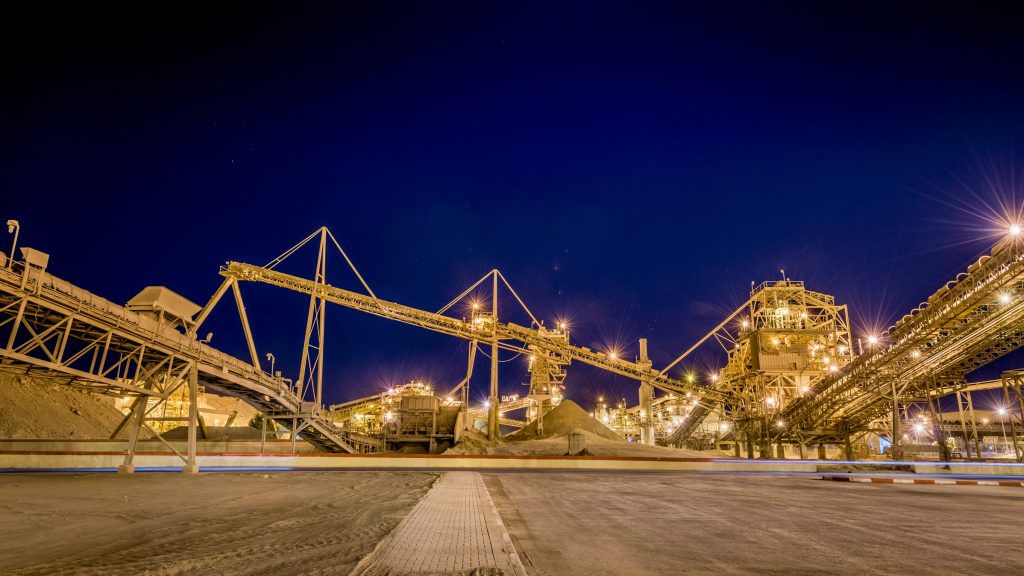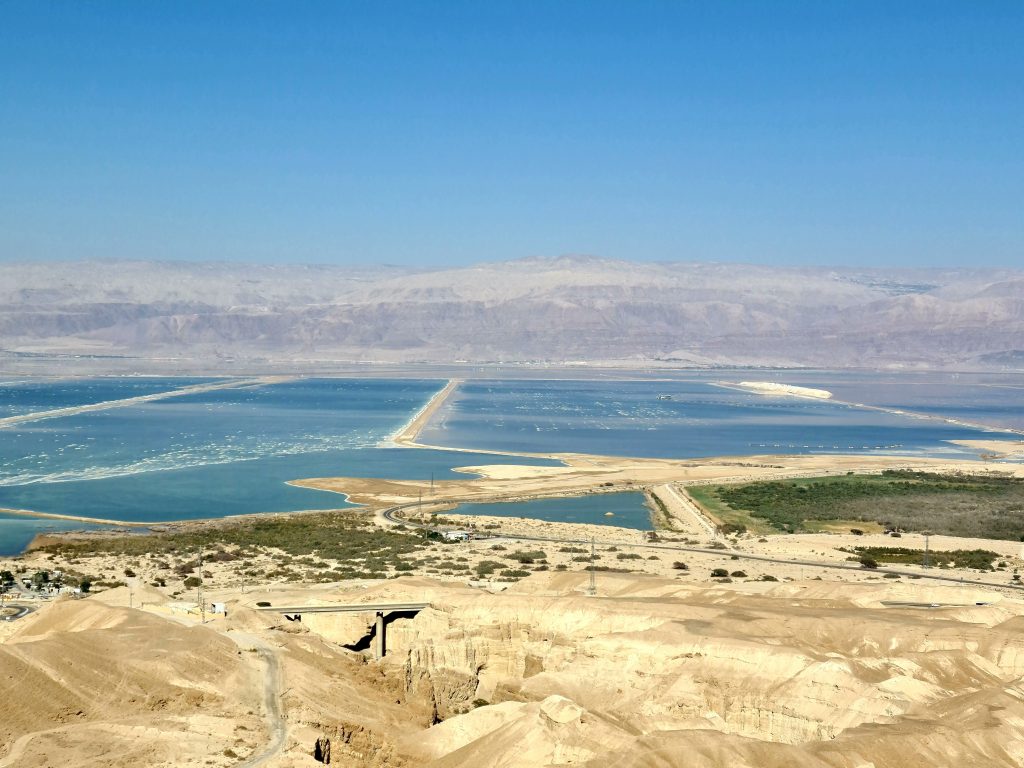Next Topic
Select SDGs to find out how we are taking action in support of the UN Substinable Development Goals
2023 ISRAEL CHEMICALS LTD. | ALL RIGHTS RESERVED

As part of the National Dead Sea development plan, the Israel Nature and Parks Authority (INPA) is leading a project for the elimination of invasive species. The goal of the project is to restore and protect the biodiversity of the region by attempting to eliminate invasive plant species that have overtaken native flora. ICL Dead Sea is taking an active role in the program and has launched, in collaboration with the INPA, a multi-stage project to eliminate invasive vegetation species at the site and to contribute to biodiversity preservation.
ICL Dead Sea initiated a project, with the assistance and guidance of the INPA, has committed to uprooting invasive plant species (mostly Washingtonia fan palms and mesquite), found on the facility’s grounds and along Route 90.

Artificial light enables us to work around the clock, but it also creates biodiversity challenges due to artificially illuminating the surroundings. The effect of artificial illumination on the natural environment is known as “light pollution”. Illuminating areas close to production sites at night is averse to the ecological balance, and could disturb animals and disrupt biological processes that occur only in the dark. Reducing light pollution could be a simple matter, such as eliminating or switching off unnecessary illumination, reducing the intensity of lighting installations, restricting its hours of use, or selecting different types of illumination, such as focused torches instead of lighting with ball symmetry.
ICL Dead Sea’s production sites are located in a sensitive region, from a panoramic and ecological perspective, and therefore it is important to reduce, as much as possible, its effect on the environment and ecosystems. In recent years, ICL Dead Sea has been addressing the challenge of reducing light pollution in several ways:
The southern portion of the ICL Dead Sea site encompasses 36,000 hectares in the Judean Desert near the Dead Sea. This area contains distinctive panoramic, geological and historical attributes, some of which have been impacted by ICL Dead Sea’s quarrying, mining and drilling activities, as well as other factors unrelated to the Company. ICL Dead Sea has initiated and is engaged in various rehabilitation and restoration projects within its concession area. The Company continues its efforts to minimize its environmental footprint.
ICL is also working on restoration projects with partners such as the Tamar Regional Council, The Israeli Ministry of Environmental Protection and the Nature and Parks Authority. Projects include a restoration plan at the Heimar Stream Estuary, providing organized safe access to public open areas, conservation of the Sdom Saltmarsh Lake, and making it accessible to the general public.
The scenic view of the Dead Sea is unique in Israel and the world. One of the areas that were neglected with historic environmental hazards was located on the edge of ICL DS’s pond 35, the Tamarit site. Historically, municipal wastewater ponds were located there, as was a pirate landfill containing construction waste. For travelers on Road 90, the line of sight towards the ponds was blocked by piles of waste and debris. ICL DS offered to engage in a panoramic restoration by using excess salt, dug up from pond 35 and regular maintenance. Landscape architect, Nimrod Amado, planned the landscape for observation posts made of salt overlooking the amazing view of pond 5 (the Dead Sea hotels complex is located on its shores). The site was developed by ICL, in cooperation with the Tamar Municipal Council, and is expected to open to the public during 2023.

Water flowing in the Bokek Stream has turned salty in the past decades. Due to the ecological importance of the area, ICL DS, in cooperation with Israel’s Nature and Parks Authority, pays for fresh water to flow through the stream and for clearing of the salt water, transferring it out of the stream.
Over the past several decades, ICL Dead Sea has carried out various earthworks in open areas that are a part of the Company’s concession area, to support its production facilities. These resulted in various environmental disruptions and hazards which ICL Dead Sea, in recent years, has resolved to address by restoration, in collaboration with the Ministry of Environmental Protection and the Israel Nature and Parks Authority. In the future, ICL Dead Sea plans to continue upgrading some of the sites to make them accessible to the public.
By Geoteva




The Arava stream canyon constitutes a sort of natural border between Israel and the Kingdom of Jordan. It begins south of ICL Dead Sea’s most southern evaporation pond, continues between the Jordanian evaporation ponds to the east, and ICL Dead Sea’s ponds to the west, and from there continues north towards its end in the northern basin of the Dead Sea.
The Arava stream canyon meanders in a buffer area between the Israeli and Jordanian facilities, and their brine water is discharged there, following mineral extraction.
The discharge of brines to the stream by ICL Dead Sea is transparently and continuously reported to the authorities, and conducted according to publicly available permits. It should be noted that due to this flow of brine back to the Dead Sea, ICL DS needs to pump more from the Dead Sea. In addition, and separately from the Arava stream, there is another adjacent brine flow channel, where seeping brines from ICL Dead Sea’s Pond 5 are collected. The brine flow channel is well-known and the authorities are familiar with it. Many observation visits of this area have been conducted, including by helicopter, as entry to this hazardous area (due to old land mines) is prohibited.
In the late 1970s, the northern basin, which is natural and deep, and the southern basin, which is shallow and contains ICL Dead Sea’s evaporation ponds, became severed. The buffer area between the northern and southern basins transformed into a dried-up seabed, a hazardous area due to the prevalence of sinkholes and land mines strewn throughout it. As a result of the decreasing water level in the northern basin and growing height differences, the Arava stream and the adjacent brine flow channel have both eroded. The erosion has become more significant due to the decreasing level of the Dead Sea uncovering geological phenomena that the authorities would like to preserve.
Until recently, the border with Jordan, in the Dead Sea region, was unprotected and lacked an efficient barrier to prevent crossing the Arava River from both of its sides. As such, the area was prone to trouble. For years, many intruders exploited the situation, mainly for criminal activity and contraband, or to find work.
Following a request from the IDF regarding the situation, ICL Dead Sea raised the possibility of erecting a salt wall opposite the border with Jordan. A salt wall would make efficient use of surplus salt that is piled in the area, which is a byproduct of ICL’s production process. It would act as a barrier that would contribute to security needs in the region.
The salt wall forms a natural and innovative engineering barrier, that contributes to Israel’s security, using a salt byproduct that fits the area’s landscape. The wall will be about 3 meters high on the Israeli side (above the current level of the dikes). Once the wall is completed, it will extend for 36 kilometers.
The site's engineering staff and the Israeli Defense Forces (IDF) staff are supervising the project, and the Nature and Parks Authority will approve every stage of it, in order to prevent damage to nature – fauna and flora, in the region.
This is another implementation of the circular economy, using salt, a byproduct of the potash industry for erecting a security barrier.
ICL Dead Sea, in coordination with The Council for Conservation of Heritage Sites in Israel, converted an old worker camp of the Eretz-Israeli Potash Company into a new visitor center. The visitors center opened to the public at the end of 2021. The visitor center includes exhibits with three main themes:
The site was constructed on the historic workers camp location. Much work has been invested in rehabilitation and preservation of the historic structures, in collecting information and in constructing simulation and presentation facilities using advanced technology. The structures were rehabilitated, some of them were reconstructed according to the original plans that were located and the historic site came back to life.
Close to ILS 50 million have been invested in the project.


Heimar Stream, one of the longest creeks in the Judean desert, contains unique geography and biodiversity, including rare plants, animals and geological formations. In the midst of this environment, extensive mining and water infrastructure work (damming and flow channels) have been conducted over many years, including drilling and pumping stations for ICL Dead Sea Works. The Company, in cooperation with the INPA and the Tamar Regional Council, formed a plan for the integrated restoration of the area. The plan includes panoramic and ecological restoration of damaged areas, as well as restoration of areas for tourism development in the areas adjacent to the road. ICL has selected a plan involving minimum development – that will provide hikers with an opportunity to explore the area without damaging it. This plan will allow for mining activity to continue in parallel with restoration of the entire area. The detailed plan was approved in 2017.
In 2020, a steering committee for the restoration of Nahal Heimar (downstream) was formed. The participants in the committee include ICL DS, the Nature and Parks Authority’s East Negev environmental unit and others. The committee is advancing different restoration plans for the Nahal Heimar area. Work at the field is expected to begin towards the end of 2022.

